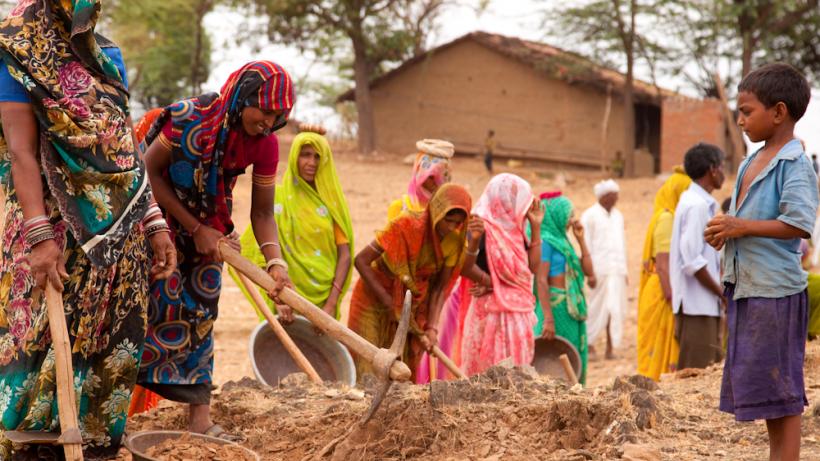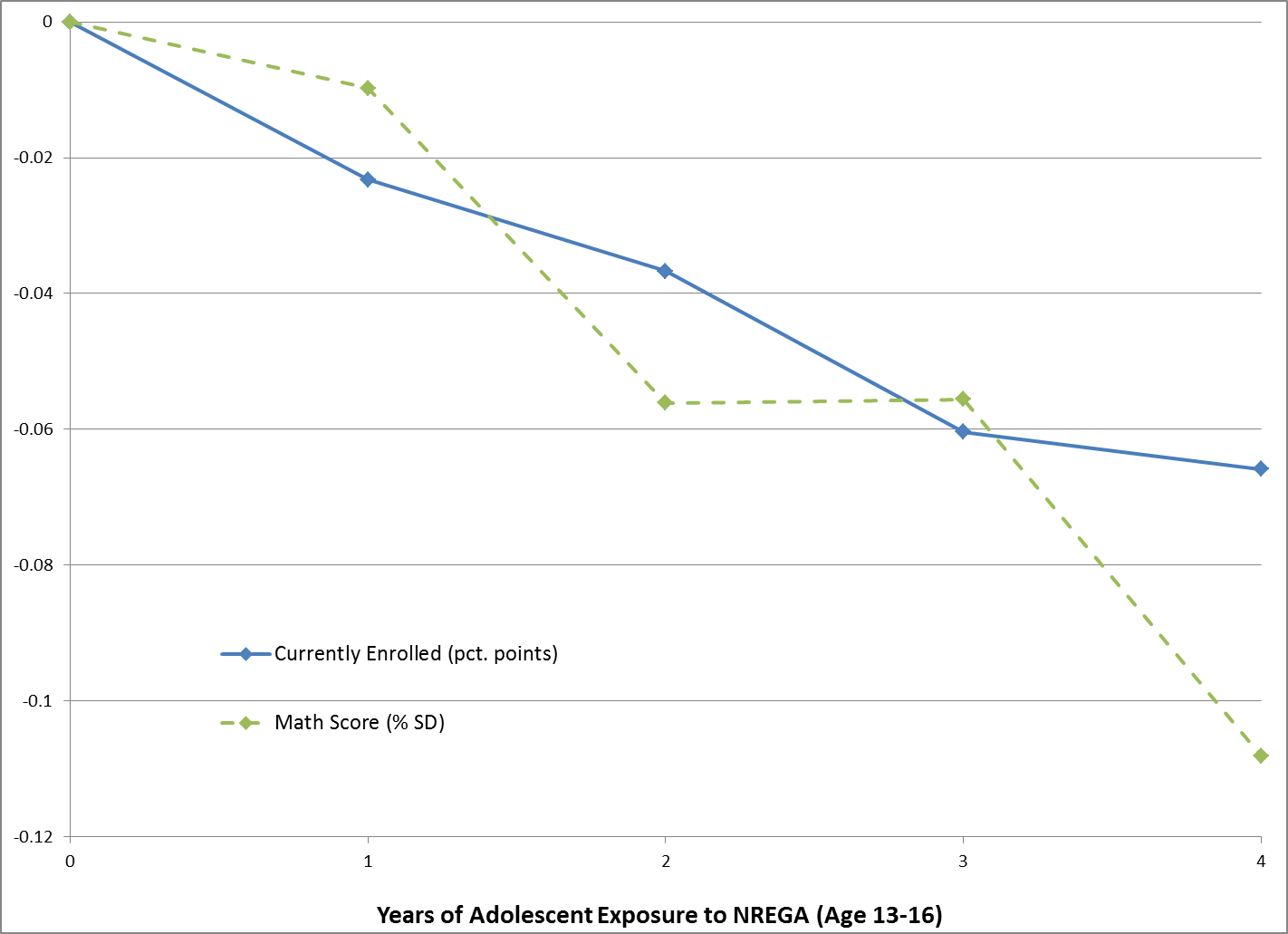
Do workfare programmes reduce educational attainment? Evidence from India
Workfare programmes have become an increasingly common form of social transfer. From 2007-2009, the World Bank alone funded workfare programmes in 24 different countries. While they offer a valuable safety net to households in lean times, workfare programmes can also produce unintended effects. Looking at the case of NREGA in India, today’s blog argues that a better understanding of ‘price effects’ is needed to improve targeting and reduce trade-offs to education.
Much of the popularity of workfare programmes stems from the fact that they are self-targeting. Only individuals willing to work (hard), and sufficiently in need of work, will accept low wages and sign up to receive the subsidy. Workfare programmes are also intended to prevent dependency. As better labour market opportunities arise, participants will turn away from public works. Programmes may also increase private sector wages, thereby further increasing incomes of the poor.
India's National Rural Employment Guarantee Act (NREGA), passed in 2005, provides a legal guarantee of up to 100 days of annual employment at the statutory minimum wage rate to rural households willing to supply manual labour for local public works in a financial year. The Act mandates equality of wages for men and women and that one-third of programme beneficiaries are to be women. It is operationalised through the National Rural Employment Guarantee Scheme (NREGS), which began in 2006. In 2009-10, approximately 53 million households across India were beneficiaries of NREGS. The required budgetary outlay was approximately Rs. 40,000 crores (over 6 billion US dollars), making it one of the best-endowed social programmes in India.
NREGA provides jobs, not just payments.
Imbert and Papp (2015) show that NREGS increased rural wages about 5 percent which suggests that NREGA acts as a positive shock to labour demand in villages. The programme affects the opportunity cost of time even for people who are not allowed to work directly for the programme, like teenagers.
From previous work, we know that the opportunity cost of time is an important determinant of investment in education. For example, our own work shows that when rainfall is high and rural labour market opportunities are abundant, people invest less in education or ‘human capital’ development of older children; others have shown similar patterns from factory openings in Mexico and fracking and housing booms in the U.S. Thus, if workfare programmes are raising wages and changing the opportunity cost of time in school for adolescents, there could be knock-on effects for a household's education decisions.
...when rainfall is high and rural labour market opportunities are abundant, people invest less in education or 'human capital' development of older children
In a recent working paper, “Workfare and Human Capital Investment: Evidence from India” we examine the effect of NREGS on human capital outcomes. We take advantage of the phased rollout of the programme over three years to identify the causal effect of the programme on human capital. We measure human capital using the 2005-2009 Annual Status of Education Report (ASER) data. ASER annually tests over 500,000 children between the ages of 5 and 16 from almost 600 rural districts in India in basic literacy and numeracy skills. We use test scores in math and literacy as well as current enrollment rates and age for grade as measures of human capital.
We find that after controlling for natural differences between study settings and time periods, in villages exposed to NREGA, adolescents aged 13-16 score lower on math tests, and are less likely to be enrolled in school. For readers interested in the econometrics, we used district and year fixed effects to find that adolescents exposed to NREGA score .02-.05 standard deviations lower on math tests than adolescents not living in NREGA villages.
Figure 1: Effect of years of exposure to NREGA on enrollment and math scores

...in villages exposed to NREGA, adolescents aged 13-16 score lower on math tests, and are less likely to be enrolled in school.
Figure 1 shows that each additional year of exposure from 2006-2009 decreases math scores for 13- to 16-year-olds by 2 percent of a standard deviation and enrollment rates by 2 percentage points.
For older children, less time in school means more time in work
To understand the mechanisms behind these effects, we turn to the National Sample Survey (NSS) data, a large household survey on employment and consumption. These data confirm our findings from the ASER—when NREGS rolls out, children are 3 percentage points less likely to report school as their “primary activity”. What are they doing instead? Interestingly, boys report increases in market work, but girls report increases in domestic work at home—the exact type of work their mothers are switching out of when NREGS comes to the district.
Interestingly, boys report increases in market work, but girls report increases in domestic work at home—the exact type of work their mothers are switching out of when NREGS comes to the district.
We do find a silver lining, however. Consistent with previous research on the positive effects of income on young children’s human capital, we find that exposure to the programme before age 5 is associated with higher test scores and enrollment rates. Since the programme is less than ten years old, we don’t yet know how it will affect overall educational attainment over the long-term, but it is possible that those exposed to the increased income from the programme while young, will be less likely to drop out in the future.
Factoring in ‘price effects’ can improve social programming design
In its first four years, we estimate that NREGS caused between 650,000 and 2 million adolescents to drop out of school. While this is an important effect for long-term economic growth, it should not be taken as a complete condemnation of this programme, or others like it. This analysis represents the effect of NREGS on one particular outcome that may be of interest to policymakers (human capital investment). While we would argue that this is quite an important outcome for economic growth, we are not measuring any of the potential benefits that the programme provides in terms of consumption, protection against income shocks, or any number of other welfare outcomes. Thus, we are not in a position to measure the overall welfare impact of this particular anti-poverty programme.
Rather, the takeaway from these results is that social programmes have ‘price effects’ meaning that they affect and impact the market value and demand for labour. These price effects have very real consequences. If workfare programmes raise prevailing wages and cause older students to substitute toward work and away from school, lump sum grants or conditional cash transfers might be alternative options to consider. Ultimately, it is important to understand these price effects so that social programmes can be designed to better maximise their potential to increase economic growth and alleviate poverty.
Further Reading
Atkin, D. (2015). Endogenous skill acquisition and export manufacturing in Mexico (No. w18266). National Bureau of Economic Research.
Besley, T., & Coate, S. (1992). Workfare versus welfare: Incentive arguments for work requirements in poverty-alleviation programs. The American Economic Review, 249-261.
Cascio, E. U., & Narayan, A. (2015). Who Needs a Fracking Education? The Educational Response to Low-Skill Biased Technological Change.
Dutta, P., Murgai, R., Ravallion, M., & Van de Walle, D. P. (2012). Does India's employment guarantee scheme guarantee employment?. World Bank Policy Research Working Paper, (6003).
Charles, K. K., Hurst, E., & Notowidigdo, M. J. (2015). Housing Booms and Busts, Labor Market Opportunities, and College Attendance (No. w21587). National Bureau of Economic Research.
Imbert, C., & Papp, J. (2015). Labor market effects of social programs: Evidence from India's employment guarantee. American Economic Journal: Applied Economics, 7(2), 233-263.
Shah, M., & Steinberg, B. M. (2013). Drought of Opportunities: Contemporaneous and Long term Impacts of Rainfall Shocks on Human Capital. Forthcoming Journal of Political Economy.
Shah, M., & Steinberg, B. M. (2015). Workfare and Human Capital Investment: Evidence from India (No. w21543). National Bureau of Economic Research.
Subbarao, K., Del Ninno, C., Andrews, C., & Rodríguez-Alas, C. (2012). Public works as a safety net: design, evidence, and implementation. World Bank Publications.

